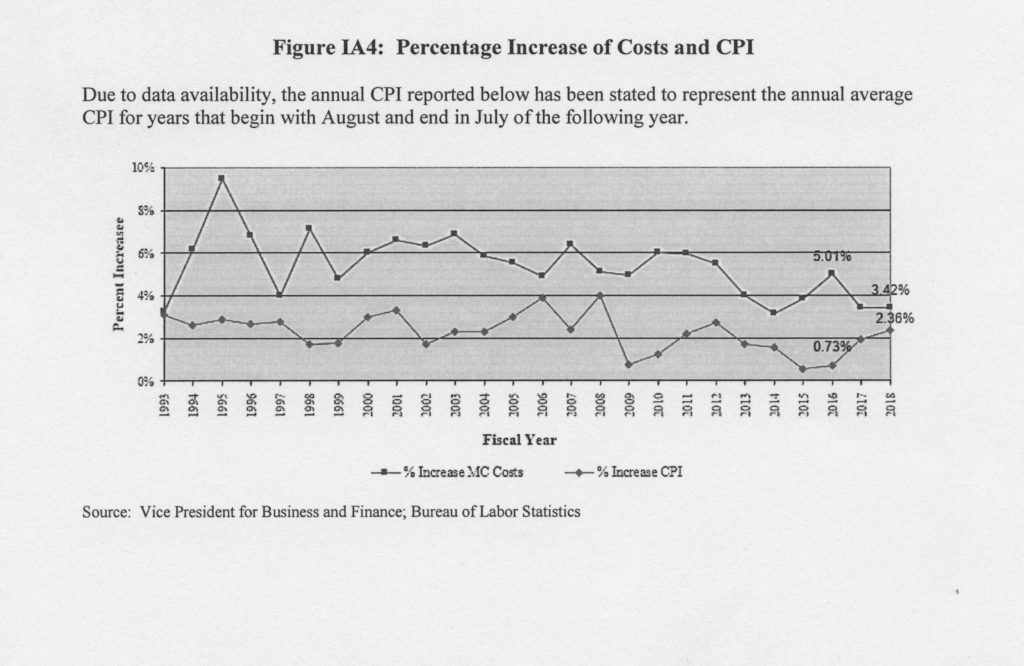“Here you can see where we have charted it against inflation and you can see we are getting closer and closer to the inflation [rate]. We have tracked it pretty close and… it’s hard to do in one year, [and] it’s something that you have to work at over time to make happen.”
Graph provided by President’s office
Earlier in the semester, Jacqui Steadman, vice president for business and finance, sent out a campus-wide email detailing cost information for the 2019-2020 school year. The email provided details about the breakdown of tuition and announced that the increase for the total traditional cost of undergraduate students is seeing the lowest increase in over 25 years.
President Bill Greer answered a few questions regarding the tuition increase.
Whitson: For the 2019-2020 school year, the percent increase in the total cost is the lowest in over 25 years. What factors allowed for the increase to be this low?
Greer: “Over the last several years, we have done everything we can to contain cost and to be sensitive to the growing concern among families and students about escalating tuition costs. We’re trying to grow some programs that will increase revenue which allows us to have lower increases. Our goal is really to be as close as possible to the overall inflation rate in the economy, and we are really close at roughly 2.8 percent. It is as close as we have been in decades to what inflation is.”
Whitson: Since the 2010-2011 school year, there has been a general decline in the percent increase of cost per year. However, there is a slight increase that stands out in the 2016-2017 school year. What could have caused this to occur?
Greer: “Most of the time what drives tuition increases are related to utilities, insurance, and salaries for faculties and staff. Healthcare insurance has really been a highly unpredictable thing, and my guess is that there was a bump there because we have had in the past few years lots of unpredictability regarding insurance and insurance premiums.”
Whitson: How does enrollment affect the total cost per student?
Greer: “It’s not so much affecting cost, it affects revenue– the higher the enrollment, the higher our revenue. When you have more students enrolled, whatever your costs are in total, gets divided out by more people. That way overall tuition per student can be managed better. On our census date we were right around 1,235-1,240, which is the highest we have ever been. We particularly benefited from increases in graduate enrollment, and Emmanuel Christian Seminary is at the highest enrollment that it has been at in over 10 years.”
Whitson: The 2018 President’s report showed that Milligan’s endowment is at its highest in history. In what ways does the endowment play a role in the total cost for students?
Greer: “The endowment generates earnings that go into our budget as income, and the higher that number can be, the less of our expenses we have to cover with tuition. That’s why we are working hard to grow the endowment. The larger we can get the endowment, the better it is for the students, because that gives us permanent resources that generate earnings that help cover the cost of operating the school. For every dollar that gets covered with either gifts or endowment income, that’s a dollar that tuition doesn’t have to cover.”
Whitson: Could the Milligan masterplan for expansion affect the total cost down the road or is it already taken into consideration?
Greer: “It is taken into consideration, [but] it would not affect tuition, at least not directly. Since we are a private institution we do not receive capital dollars from the state. We have to raise that money privately. The only instance where there might be an impact in tuition might be if, let’s say, we built a $10 million building, and we raised eight but needed to pay for two. [If] we issued bonds or something like that for the rest, and we had to build that into our budget then that might hit tuition.
Whitson: Is there anything else you would like to say about the subject?
Greer: “I would love for tuition increase to be zero, but because we live in a world in which things get expensive every year, it’s unlikely that it’s ever zero. Sometimes you see schools that will play games a little bit with their tuition and make it appear that there’s no tuition increase, but generally what’s happened is the quoted published tuition price may drop, but the amount of money that they are awarding to students to come also drops. Our ability to award good healthy merit scholarship awards makes us very competitive, so when we announce a 2.5-2.8 percent increase, it’s really because we are just trying to be ready for increased costs and make sure we are remaining financially sound and secure– our students need us to be that, too, to continue operating long term.”

